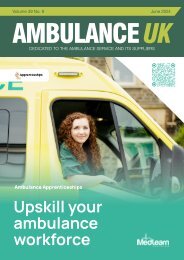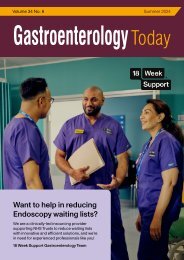Ambulance UK August 2022
Ambulance UK August 2022
Ambulance UK August 2022
You also want an ePaper? Increase the reach of your titles
YUMPU automatically turns print PDFs into web optimized ePapers that Google loves.
NEWSLINE<br />
patient to hospital, to managing<br />
more than half of patients onscene.<br />
During the COVID-19 pandemic,<br />
Adrian was asked to focus on<br />
infection prevention and control,<br />
providing senior leadership for a<br />
range of projects, including the<br />
introduction of improved PPE for<br />
staff and the launch of the staff<br />
vaccination programme.<br />
Adrian says: “To be honest, I was<br />
quite taken aback to find myself<br />
on the New Year’s Honour’s List.<br />
“My role over the years has been<br />
to constantly focus on the care<br />
we provide to our patients, and<br />
to support developments which<br />
improve that care.<br />
“The clinical team provide a toolkit<br />
of guidelines and interventions for<br />
our frontline clinicians. However,<br />
it’s our clinicians who then take<br />
that toolkit, and use it to deliver<br />
the best care they can to our<br />
patients.<br />
“They’ve worked tirelessly<br />
delivering care throughout the<br />
pandemic and they are the ones<br />
who really deserve an award.”<br />
The Queen’s <strong>Ambulance</strong> Service<br />
Medal is awarded to a handful<br />
of people each year who have<br />
given service characterised by<br />
exceptional devotion to duty and<br />
marked by outstanding ability.<br />
Adrian, who graduated from<br />
the University of Hertfordshire in<br />
2002 as one of the first degreelevel<br />
paramedics in the <strong>UK</strong>, was<br />
appointed Deputy Director of<br />
Clinical Care for SWASFT in 2010.<br />
Groundbreaking<br />
Coventry University<br />
research could<br />
hand life-saving<br />
boost to paramedics<br />
treating pedestrian<br />
casualties<br />
Groundbreaking Coventry<br />
University research could<br />
provide paramedics with crucial<br />
and potentially life-saving<br />
assistance when treating<br />
pedestrians hurt in road<br />
accidents.<br />
A detailed database of pedestrian<br />
injuries is being developed<br />
alongside a mathematical model,<br />
which can reverse-engineer<br />
pedestrian collisions and produce<br />
first-hand virtual CT scans from<br />
simple photographs of a patient’s<br />
injuries and the vehicle involved.<br />
These virtual CT scans of the<br />
body can inform paramedics,<br />
in seconds, about the victim’s<br />
potential internal injuries per<br />
organ, enabling the correct<br />
treatment at the scene. The<br />
information could also be sent to<br />
a hospital, thus speeding up the<br />
triage and improving the treatment<br />
of the casualty upon their arrival in<br />
Accident and Emergency units.<br />
Dr Christophe Bastien and<br />
colleagues at Coventry<br />
University’s research Centre<br />
for Future Transport and Cities<br />
are developing this Forensic<br />
Pedestrian Trauma Database<br />
(FPTD) in conjunction with<br />
University Hospitals Coventry and<br />
Warwickshire (UHCW) following<br />
funding support from The Road<br />
Safety Trust.<br />
The research has been chosen<br />
as a winner of the Prince Michael<br />
International Road Safety Award<br />
which recognises outstanding<br />
achievement and innovation<br />
in worldwide road safety<br />
improvement.<br />
Dr Christophe Bastien, Associate<br />
Professor (Academic) at Coventry<br />
University’s Centre for Future<br />
Transport and Cities, said: “The<br />
mathematical model, with the help<br />
of basic photography, essentially<br />
reverse-engineers pedestrian<br />
collisions, which through our<br />
framework can then provide<br />
paramedics with key information<br />
on potential injuries they usually<br />
would not have access to whilst<br />
responding to an incident onscene.<br />
We’re optimistic about<br />
the potential of such crucial<br />
assistance to help paramedics<br />
save the lives and improve the<br />
treatment of pedestrians who<br />
have been involved in traffic<br />
collisions and incidents.<br />
“In the long term, we’re very<br />
hopeful that we can develop our<br />
detailed framework into something<br />
that can be rolled out within the<br />
NHS and to health care services<br />
around the world.<br />
“For me and the teams, winning<br />
the Prince Michael International<br />
Road Safety Award represents the<br />
crowning of decades of research,<br />
positioning Coventry University as<br />
a respected and highly credible<br />
transport safety research partner<br />
worldwide.<br />
“Our next step is to secure<br />
funding to continue the<br />
development of the FPTD. Our<br />
research brings huge interest from<br />
hospitals, ambulance services,<br />
transport forensics and the<br />
police.”<br />
Gary Gilkes has worked in the<br />
ambulance service for the last<br />
ten years as a paramedic as<br />
well as lecturing at universities<br />
across the country. He’s attended<br />
multiple serious incidents and<br />
also works to help implement<br />
new ideas within the NHS and the<br />
ambulance service.<br />
He said: “Pedestrian trauma<br />
injuries can be very emotional and<br />
human factors can slow down<br />
the process of triage, so having<br />
a way to speed up this process<br />
and minimise these human factors<br />
would undoubtedly improve<br />
patient outcomes and save lives.<br />
“It’s unquestionable that speed<br />
in terms of the speed of getting<br />
patients into hospitals and starting<br />
treatment saves lives – the quicker<br />
we can do that the better chance<br />
the patient has.<br />
“There’s no doubt in my mind that<br />
this research and this framework<br />
will certainly improve the speed in<br />
which clinicians can triage injury<br />
patterns to be able to update<br />
hospitals so they can prepare<br />
treatment packages and we can<br />
start early interventions treatment<br />
on scene so these injuries don’t<br />
cause life-changing scenarios or<br />
conditions.”<br />
Sally Lines, CEO of The Road<br />
Safety Trust, said: “The findings<br />
from the research that Coventry<br />
University has conducted have<br />
the potential to assist the <strong>UK</strong><br />
Police Force and Accident and<br />
Emergency departments with<br />
road traffic collision insight. As<br />
a charity dedicated to achieving<br />
zero road deaths and serious<br />
injuries on <strong>UK</strong> roads through our<br />
grants, we are excited by the fact<br />
that this research can help save<br />
lives in the future.”<br />
The virtual CT scans have been<br />
developed and validated using<br />
the Total Human Model for Safety<br />
(THUMS) which has been devised<br />
by the Toyota Motor Corporation<br />
and Toyota Central R&D Labs.<br />
AMBULANCE <strong>UK</strong> - AUGUST<br />
For the latest <strong>Ambulance</strong> Service News visit: www.ambulancenewsdesk.com<br />
123

















